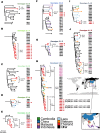Whole Genome Sequence Analysis of Salmonella Typhi Isolated in Thailand before and after the Introduction of a National Immunization Program
- PMID: 28060810
- PMCID: PMC5245908
- DOI: 10.1371/journal.pntd.0005274
Whole Genome Sequence Analysis of Salmonella Typhi Isolated in Thailand before and after the Introduction of a National Immunization Program
Abstract
Vaccines against Salmonella Typhi, the causative agent of typhoid fever, are commonly used by travellers, however, there are few examples of national immunization programs in endemic areas. There is therefore a paucity of data on the impact of typhoid immunization programs on localised populations of S. Typhi. Here we have used whole genome sequencing (WGS) to characterise 44 historical bacterial isolates collected before and after a national typhoid immunization program that was implemented in Thailand in 1977 in response to a large outbreak; the program was highly effective in reducing typhoid case numbers. Thai isolates were highly diverse, including 10 distinct phylogenetic lineages or genotypes. Novel prophage and plasmids were also detected, including examples that were previously only reported in Shigella sonnei and Escherichia coli. The majority of S. Typhi genotypes observed prior to the immunization program were not observed following it. Post-vaccine era isolates were more closely related to S. Typhi isolated from neighbouring countries than to earlier Thai isolates, providing no evidence for the local persistence of endemic S. Typhi following the national immunization program. Rather, later cases of typhoid appeared to be caused by the occasional importation of common genotypes from neighbouring Vietnam, Laos, and Cambodia. These data show the value of WGS in understanding the impacts of vaccination on pathogen populations and provide support for the proposal that large-scale typhoid immunization programs in endemic areas could result in lasting local disease elimination, although larger prospective studies are needed to test this directly.
Conflict of interest statement
The authors have declared that no competing interests exist.
Figures





Similar articles
-
Salmonella enterica serovar Typhi Ty21a expressing human papillomavirus type 16 L1 as a potential live vaccine against cervical cancer and typhoid fever.Clin Vaccine Immunol. 2007 Oct;14(10):1285-95. doi: 10.1128/CVI.00164-07. Epub 2007 Aug 8. Clin Vaccine Immunol. 2007. PMID: 17687110 Free PMC article.
-
High-resolution genotyping of the endemic Salmonella Typhi population during a Vi (typhoid) vaccination trial in Kolkata.PLoS Negl Trop Dis. 2012 Jan;6(1):e1490. doi: 10.1371/journal.pntd.0001490. Epub 2012 Jan 31. PLoS Negl Trop Dis. 2012. PMID: 22303491 Free PMC article.
-
Population structure of Salmonella enterica Typhi in Harare, Zimbabwe (2012-19) before typhoid conjugate vaccine roll-out: a genomic epidemiology study.Lancet Microbe. 2023 Dec;4(12):e1005-e1014. doi: 10.1016/S2666-5247(23)00214-8. Epub 2023 Nov 9. Lancet Microbe. 2023. PMID: 37952554 Free PMC article.
-
Salmonella Typhi genomics: envisaging the future of typhoid eradication.Trop Med Int Health. 2017 Aug;22(8):918-925. doi: 10.1111/tmi.12899. Epub 2017 Jun 19. Trop Med Int Health. 2017. PMID: 28544285 Review.
-
Review of current typhoid fever vaccines, cross-protection against paratyphoid fever, and the European guidelines.Expert Rev Vaccines. 2017 Oct;16(10):1029-1043. doi: 10.1080/14760584.2017.1374861. Expert Rev Vaccines. 2017. PMID: 28856924 Review.
Cited by
-
Typhoidal Salmonella Trends in Thailand.Am J Trop Med Hyg. 2018 Sep;99(3_Suppl):64-71. doi: 10.4269/ajtmh.18-0046. Epub 2018 Jul 24. Am J Trop Med Hyg. 2018. PMID: 30047363 Free PMC article.
-
Genotypic Diversity among Salmonella Typhi Isolated from Children Living in Informal Settlements in Nairobi, Kenya.Int J Clin Microbiol. 2024;1(3):18-27. doi: 10.14302/issn.2690-4721.ijcm-24-5195. Epub 2024 Sep 16. Int J Clin Microbiol. 2024. PMID: 39483419 Free PMC article.
-
Whole genome sequence analysis of Salmonella Typhi provides evidence of phylogenetic linkage between cases of typhoid fever in Santiago, Chile in the 1980s and 2010-2016.PLoS Negl Trop Dis. 2022 Jun 29;16(6):e0010178. doi: 10.1371/journal.pntd.0010178. eCollection 2022 Jun. PLoS Negl Trop Dis. 2022. PMID: 35767580 Free PMC article.
-
Persistence of Rare Salmonella Typhi Genotypes Susceptible to First-Line Antibiotics in the Remote Islands of Samoa.mBio. 2022 Oct 26;13(5):e0192022. doi: 10.1128/mbio.01920-22. Epub 2022 Sep 12. mBio. 2022. PMID: 36094088 Free PMC article.
-
Childhood Diarrhoea in the Eastern Mediterranean Region with Special Emphasis on Non-Typhoidal Salmonella at the Human⁻Food Interface.Pathogens. 2019 May 6;8(2):60. doi: 10.3390/pathogens8020060. Pathogens. 2019. PMID: 31064086 Free PMC article. Review.
References
Publication types
MeSH terms
Substances
Grants and funding
LinkOut - more resources
Full Text Sources
Other Literature Sources

